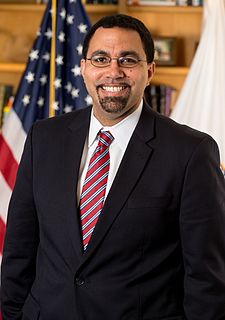Related Research Articles
Education Reform in the United States is the name given to the goal of changing public education. Historically, reforms have taken different forms because the motivations of reformers have differed. However, since the 1980s, education reform has been focused on changing the existing system from one focused on inputs to one focused on outputs. In the United States, education reform acknowledges and encourages public education as the primary source of K-12 education for American youth. Education reformers desire to make public education into a market, where accountability creates high-stakes from curriculum standards tied to standardized tests. As a result of this input-output system, equality has been conceptualized as an end point, which is often evidenced by an achievement gap among diverse populations. This conceptualization of education reform is based on the market-logic of competition. As a consequence, competition creates inequality which has continued to drive the market-logic of equality at an end point by reproduce the achievement gap among diverse youth. The one constant for all forms of education reform includes the idea that small changes in education will have large social returns in citizen health, wealth and well-being. For example, a stated motivation has been to reduce cost to students and society. From ancient times until the 1800s, one goal was to reduce the expense of a classical education. Ideally, classical education is undertaken with a highly educated full-time personal tutor. Historically, this was available only to the most wealthy. Encyclopedias, public libraries and grammar schools are examples of innovations intended to lower the cost of a classical education.
Education in the United States is provided in public, private, and home schools.
English as a second or foreign language is the use of English by speakers with different native languages. Language education for people learning English may be known as English as a second language (ESL), English as a foreign language (EFL), English as an additional language (EAL), or English for speakers of other languages (ESOL). The aspect in which ESL is taught is referred to as Teaching English as a Foreign Language (TEFL), Teaching English as a Second Language (TESL) or Teaching English to Speakers of Other Languages (TESOL). Technically, TEFL refers to English language teaching in a country where English is not the official language, TESL refers to teaching English to non-native English speakers in a native English speaking country and TESOL covers both. In practice however, each of these terms tends to be used more generically across the full field. The one you are more likely to hear depends largely on your location - with TEFL more widely used in the UK and TESL or TESOL in the US.
Achievement gaps in the United States are observed, persistent disparities in measures of educational performance among subgroups of U.S. students, especially groups defined by socioeconomic status (SES), race/ethnicity and gender. The achievement gap can be observed on a variety of measures, including standardized test scores, grade point average, dropout rates, and college enrollment and completion rates. While this article focuses on the achievement gap in the United States, the gap in achievement between lower income students and higher income students exists in all nations and it has been studied extensively in the U.S. and other countries, including the U.K. Various other gaps between groups exist around the globe as well.
A school counselor works in primary schools and/or secondary schools to provide academic, career, college access/affordability/admission, and social-emotional competencies to all students through a school counseling program.

Berkeley High School is a public high school in the Berkeley Unified School District, and the only public high school in the city of Berkeley, California, United States. It is located one long block west of Shattuck Avenue and three short blocks south of University Avenue in Downtown Berkeley, and is recognized as a Berkeley landmark. The school mascot is the Yellowjacket.
Culturally relevant teaching or responsive teaching is a pedagogy grounded in teachers' displaying cultural competence: skill at teaching in a cross-cultural or multicultural setting. Teachers using this method encourage each student to relate course content to his or her cultural context.
Inclusion in education refers to a model wherein students with special needs spend most or all of their time with non-special needs students. It arise in the context of special education with an individualized education program or 504 plan, and is built on the notion that it is more effective for students with special needs to have said mixed experience for them to be more successful in social interactions leading to further success in life. Inclusion rejects but still provides the use of special schools or classrooms to separate students with disabilities from students without disabilities. Schools with inclusive classrooms do not believe in separate classrooms. They do not have their own separate world so they have to learn how to operate with students while being less focused on by teachers due to a higher student to teacher ratio.
The history of school counseling around the world varies greatly based on how different countries and local communities have chosen to provide academic, career, college readiness, and personal/social skills and competencies to K-12 children and their families based on economic and social capital resources and public versus private educational settings in what is now called a school counseling program.
Tracking is separating students by academic ability into groups for all subjects or certain classes and curriculum within a school. It may be referred to as streaming or phasing in certain schools.
Educational inequality is the unequal distribution of academic resources, including but not limited to; school funding, qualified and experienced teachers, books, and technologies to socially excluded communities. These communities tend to be historically disadvantaged and oppressed. More times than not, individuals belonging to these marginalized groups are also denied access to the schools with abundant resources. Inequality leads to major differences in the educational success or efficiency of these individuals and ultimately suppresses social and economic mobility. See Statistic sections for more information.
Internationals Network for Public Schools is an educational nonprofit supporting International high schools and academies, serving newly arrived immigrants who are English language learners (ELLs), in New York, California, Kentucky, Maryland, Virginia, and Washington, DC. Internationals Network also partners with other schools and districts across the country.
Ronald F. Ferguson in Cleveland, Ohio is an economist who researches factors that affect educational achievement. Major themes in his work include the race-related achievement gap in the United States and how to improve schools and identify effective teachers.
The racial achievement gap in the United States refers to disparities in educational achievement between differing ethnic groups. It manifests itself in a variety of ways: among students, African-Americans, Latinos, and Chicano students are more likely to receive lower grades, score lower on standardized tests, drop out of high school, and they are less likely to enter and complete college than whites, while whites score lower than Asian Americans. There is disagreement among scholars regarding the origins of the racial achievement gap. Some focus on the home life of individual students, and others focus more on unequal access of certain ethnic groups to resources. Such as the fact that every dollar the board spent on a black or brown student, equals up to seven spent on a white student. Additionally, political histories such as anti-literacy laws and current policies such as school funding have resulted in a education debt between districts, schools, and students. The achievement gap effect economic disparities internally, the future of the national economy, political participation, and political representation. Solutions have ranged from national with policies such as No Child Left Behind and more recently the Every Student Succeeds Act to private industry closing this gap and even local efforts.
A full-service community school (FSCS) or a community school in the United States focuses on partnerships between a school and its community. It integrates academics, youth development, family support, health and social services, and community development. Community schools are organized around the goals to help students learn and succeed and to strengthen families and communities. Full-service community schools extend the goals of traditional public schools further. They are centers of their communities that provide services to address the needs of student learners and build bridges between schools, families, and communities. They are schools that not only promote academic excellence, but they also provide health, mental health, and social services on the school campus. The "school emerges as a community hub, a one-stop center to meet diverse needs and to achieve the best possible outcomes for each child."

John B. King Jr. is the President and CEO of The Education Trust. He served as the 10th United States Secretary of Education from 2016 to 2017. Immediately before he assumed leadership of the Department, he served as its Acting Deputy Secretary, and from 2011 to 2014 he was the New York State Education Commissioner. The former Secretary of Education, Arne Duncan, was charged with implementing the No Child Left Behind Act; however, King was obliged to carry out the provisions of that law's modified successor legislation, the Every Student Succeeds Act.
Social justice educational leadership emphasizes the belief that all students can and will reach proficiency, without exceptions or excuses, and that schools ought to be organized to advance the equitable learning of all students. Rather than focusing on one group of students who traditionally struggle, or who traditionally succeed, social justice leaders address the learning needs of all students. Social justice educational leadership specifically addresses how differences in race, income, language, ability, gender, and sexual orientation influence the design and effectiveness of learning environments. Social justice leadership draws from inclusive education practices from disability education, but extends the concepts further to support students from diverse groups with a wide range of needs. Through restructuring staff allocation and assessing student progress through disaggregated data, school leaders strive to create schools with equal access and equitable support for all students.
Patricia A. Edwards, a member of the Reading Hall of Fame, is a Distinguished Professor of Language and Literacy in the Department of Teacher Education and a Senior University Outreach Fellow at Michigan State University. She is a nationally and internationally recognized expert in parent involvement, home-school-community partnerships, and multicultural, early, and family/intergenerational literacy with a focus on poor and minority children. She served on the International Literacy Association Board of Directors from 1998–2001, as the first African American President of the Literacy Research Association from 2006–2007, and as President of the International Literacy Association from 2010–2011. Edwards also served as a member of the Board of Directors for the American Educational Research Association's (AERA) Family, School, and Community Partnerships Special Interest Group (SIG) from 2014–2016 and was elected to serve as its President-Elect/President from 2016–2020.
Helen F. Ladd is an education economist who currently works as the Susan B. King Professor Emeritus of Public Policy and Economics at Duke University's Sanford School of Public Policy. In recognition of her research on the economics of education, she has been elected to the National Academy for Education and the National Academy of Sciences.

The COVID-19 pandemic has affected educational systems worldwide, leading to the near-total closures of schools, universities and colleges.
References
- Basch, C. E., & Duncan, D. F. (1985). Promoting high level wellness in a rural state: The wellness education workshop. Health Values, 9(4), 18-23.
- Basch, C.E. (2010). Healthier Students Are Better Learners: A Missing Link in Efforts to Close the Achievement Gap. Equity Matters: Research Review No. 6. New York: The Campaign for Educational Equity.
- Basch, C.E. (2011). Healthier students are better learners: a missing link in school reforms to close the achievement gap. Journal of School Health, 81(10), 593-598.
- Blonska, J. (March 31, 2011). Spotlight on Charles E. Basch: Healthier Students Are Better Learners. Healthy Schools Campaign, http://www.healthyschoolscampaign.org/blog/spotlight-on-charles-e-basch-healthier-students-are-better-learners
- Wethington, C. (Nov. 12, 2013). Closing the achievement gap: a new vision for making it happen. MinnPost, Community Voices http://www.minnpost.com/community-voices/2013/11/closing-achievement-gap-new-vision-making-it-happen